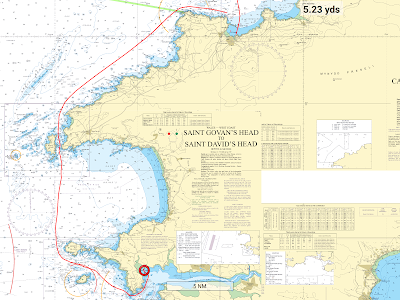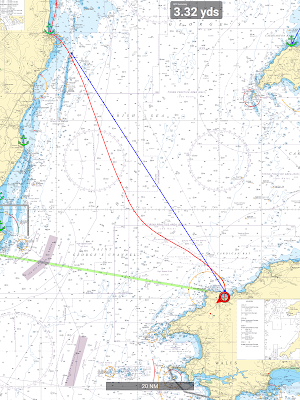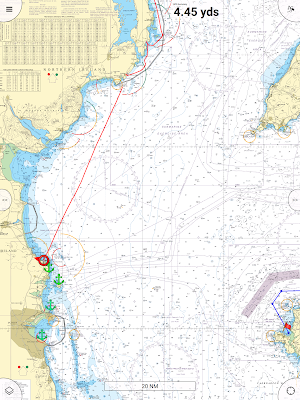WIP
Thursday a.m.
There were two unpleasant weather surprised this morning, first when I woke up there was thick fog with visibility down to 70 or 80 yards - that was not in yesterdays forecasts. By 10:30 that had thinned so I can see the coast line 400 yards away at times, it should lift fairly quickly, but it is now forecast for tomorrow. I guess with warm air flowing in from the south I (and the forecasters!) should not have been surprised about some advection fog in the mornings.
The second and more serious surprise is this morning ecmwf models for the weather at the end of next week (the UKMO does not publish beyond [but by Saturday was saying similar])
 |
This is the worst day but the forecast for the following few days quite
strong winds gusting to 30 knots in St George's Channel on the 29th |
 |
Although the timing varies a little both models agree that the
23rd is unlikely to be suitable for my to go south over
Caernarfon Bar and south on the 23rd. |
Given my dead line and assuming the forecasts do not change very quickly I need to head back sooner rather than later.
My problem now is light southerly / easterly winds in this area until Saturday afternoon when they start to increase, then on Sunday and Monday strong south-westerly as shown above.
The winds in the St Georges Channel may not be helpful tomorrow:
 |
Although it is forecast to improve during the evening, not a
problem motoring but I could do without it. |
Tides going south are not that helpful, turning foul today at Lunchtime although the wind is ESE F3 might be OK for some of the route south. Leaving here very early tomorrow morning can't be relied on due to the likelihood of fog that would be a serious problem for some miles due to all of the pot buoys.
This mornings forecast:
Forecast for Irish coastal waters from Malin Head to Carnsore Point to Loop Head and for the Irish Sea
Wind: East to southeast force 3 or less. Increasing force 3 to 5 imminently, strongest for northeast and southwest areas.
Weather: Mist and fog, especially for southern and eastern areas. Becoming mostly fair.
Visibility: Poor in mist or fog. Otherwise good.
Outlook for a further 24 hours until 06:00, Saturday 21 June 2025
High pressure across northwest Europe will continue to steer in a mostly light to moderate east to southeast flow. Low pressure in the nearby Atlantic will gradually advance eastwards too. Fair, apart from well scattered thundery showers,
According to the models the F5 referred to should be further north.
I had decided against Irelands Eye tonight as potentially uncomfortable if the wind is a tad more southerly than predicted and the same goes for Dublin Bay but I think there is now not much option. So when / if the fog lifts a bit more I am heading south to one of the above or preferably to Wicklow if the sea state suggests I could anchor there for a few hours before setting off early tomorrow, the wind should be OK, if I get there and it is not tenable (unlikely, but it could be v uncomfortable), I'll be in for an overnight trip..
I'll decide where I will head for in Wales tomorrow, probably after I have left, the main options being:
- Fishguard which is a very safe harbour unless the wind is in the north, where I can resupply (by dinghy) when my fresh food runs out.
- St Brides Bay / Skomer - I would need daylight for that as this as I have not been there before and the anchorage is tight.
- Milford - but that is a long way especially if I don't leave from Wiklow, I don't want to repeat last years rush from here to Milford.
Either way I expect a lot of motoring, fortunately I have fuel for 3 times the distance from here to Milford.
Thursday p.m.
I left at 10:45 after the fog lifted enough that I could clearly see the shore, it clamped down a bit half a mile offshore and was patchy until I was approaching Lambey Island but good enough for me to see pot buoys in time to avoid them, which I had to do on 4 occasions 2 of them would have been very close or a hit.
On radar watch I saw electronically a surprising number of small boats out in the fog.
[pics of the lifting fog etc here...........]
I was sailing from around Lochshinney but it was extremely frustrating with the wind coming and going, I would wait 5 minutes to see if the wind, or calm would persist or not then not long after it would change again. I started the engine 8 times before I gave up of Irelands Eye when what wind there was veered to the south and I motored from then on in a very calm sea.
[pics of Irelands Eye and the ferry I crossed having tracked it for over 30 miles.]
I made Wicklow and anchored a little after 8 o'clock.
Facebook Posts:
Good news, it is flat calm at Wicklow. Bad news there is a fun fair in town and ear shot. pot buoys ahead so didn’t risk going further.
 |
| 39 miles in ten and a half hours. |











.JPG)

%20pan.jpg)




.JPG)












